“The Shanghai Institute of Natural Science” designed by Uchida Yoshikazu
The Shanghai Institute of Natural Science was an institute that existed in Shanghai for 14 years from April 1931 to the end of the war in 1945.
In fact, this institute was also designed by Uchida Yoshikazu (1885-1972).
According to the “Collection of Works by Uchida Yoshikazu” (hereinafter referred to as “Collection of Works”) that I introduced earlier, there are the following comments regarding this building.
By the way, according to this “Collection of Works”, the construction was completed in 1930 (Showa 5).
*
At that time, the Ministry of Foreign Affairs had a Cultural Affairs Department, and its two major plans were to build a humanities institute in Beijing and a natural science institute in Shanghai, and the design of the architecture of the Shanghai Institute of Natural Science was left to the Professor Uchida. This is one of the largest institutes planned by Professor Uchida. Although labor was procured locally, most of the materials are said to have been selected from Japan.
A huge building has been built on a vast site that could be used as a golf course, making you feel like you are doing research at the University of Tokyo.
As I have often mentioned, the professor first thought of arranging blocks for each function, but as with the many institutes mentioned earlier, he came up with a unified structure. In the end, it’s safe to say that it suited the professor’s tastes better. He housed as much as possible in this building, except for things that were unsuitable to be housed in the same building, such as the astronomical observatory of the Faculty of Science.
The fact that the design of the institute is so similar to that of University of Tokyo, so that you might forget it was built in Shanghai, China, is not only because both of them were designed by Professor Uchida, but also because the researchers strongly desired it be “like the University of Tokyo.”
There was great cooperation from the late Mr. Shimizu Yukishige and the late Mr. Takaoka Shunzaburo (graduated from the University of Tokyo in 1925).
(Bold letters are by the author, same below)
*
The Shanghai Institute of Natural Science was built with compensation money from the “Boxer Incident”
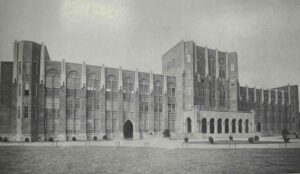
上海自然科学研究所(『内田祥三先生作品集』より)
Shanghai Natural Science Institute (from “Uchida Yoshikazu Collected Works”)
The establishment of this institute stems from the “Boxer Incident” that began in 1900.
Taking advantage of this anti-Christian movement known as the “Boxer Incident”, the Empress Dowager Cixi of the Qing Dynasty declared war against Britain, America, France, Italy, Russia, Germany, Austria, and Japan on June 21, 1900.
However, the modern forces of the eight Allied Powers were no match for them, and within two months of declaring war, the Allies had captured Beijing.
The following year, in 1901, peace was concluded between the Qing government and the Allied Powers, with the Qing Dynasty paying compensation of 450 million ryo (taels) to the Allied Powers.
This compensation will become the source of funds for the establishment of the Shanghai Institute of Natural Science.
Although this institute was sometimes seen as a base for Japan’s “cultural invasion,” it is said that the researchers who worked at the institute were generally genuinely interested in Japan-China cooperation in developing the natural sciences “for the development of China.”
Apparently it was called “Dreamland” because it was a place where research could be conducted in a free atmosphere amidst the ravages of war. (according to “The Shanghai Institute of Natural Science – Scientists’ Sino-Japanese War”, by Saeki Osamu)
Perhaps for this reason, this institute was built in the French Concession, rather than in the Hongkou area in the north of the Concession, where there were many Japanese residents.
The location is around Qiqi Road and Xujiahui Road.
The address at that time was “No. 320 Qiqi Road, Shanghai French Concession”
This would be around present-day Yueyang Road and Zhaojiaban Road.
By the way, “Qiqi” is the Chinese character for the French name Guiche.
“Shanghai Institute of Natural Science – Scientists’ Sino-Japanese War,” says as follows:
*
The design of the institute’s main building was initially entrusted to Ito Chuta and Uchida Yoshikazu, with three members from the Shanghai Committee, Irisawa, Yamazaki, and Okochi, participating in the planning process. This work began quite early on, and a tentative conclusion was reached, but a geological survey in February 1926 revealed that it would be difficult to construct the basement as planned. The design was revised under Uchida’s leadership and completed in 1928 (Showa 3), and construction was contracted to local construction company Xinlinji for 637,000 ryo (taels) and completed in September 1930 (Showa 5). However, the interior was only completed in August 1931, four months after it opened.
*
Surprisingly, Ito Chuta (1867-1954) was also involved in the design at the beginning.
Speaking of Ito Chuta, he was an architect who designed the Okura Shukokan Museum, Tsukiji Honganji Temple, Kanematsu Auditorium of the current Hitotsubashi University, and the main gate of the University of Tokyo. He was also a member of the Venue Planning Committee for the International Exposition of Japan planned in 1940 (which was canceled due to World War II).
People who visited “The Shanghai Institute of Natural Science”
Now, this institute was a facility that existed during a very unpleasant and sensitive period, from before the Sino-Japanese War until the end of World War II, and many people visited it.
According to “Shanghai Institute of Natural Science – Scientists’ Sino-Japanese War,” it says as follows:
*
However, if we look at the existence of this institute in the context of modern history, it is also true that we can glimpse its connections with a variety of historical figures and events. Great Chinese intellectuals such as Lu Xun, Hu Di, and Cai Yuanpei. Ozaki Hidemi who was executed as an accomplice in the Sorge Incident. Otani Kozui who was a mysterious monk who planned Utopia on an Asian scale. Niels Bohr, a master of theoretical physics who rivals Einstein. And Ishii Shiro of “Unit 731”, the bearer of the dark side in the history of modern Japanese science. Even if we list the names of some of these visitors who walked through the corridors of the institute, we can see there is an unexpected assortment.
*
The fact that Ishii Shiro (1892-1959) of Unit 731 was also a visitor stirs up all sorts of imaginations.
After all, one of the research departments at the Shanghai Institute of Natural Sciences was “the Department of Bacteriology.”
One of the novels set in this “The Shanghai Institute of Natural Science” is Ueda Sayuri’s “King of Ruin.”
This work is an exciting story about the development of bacterial weapons, set at the Shanghai Institute of Natural Science. Ishii Shiro from Unit 731, mentioned above, also appears.
For those interested in the “The Shanghai Institute of Natural Science,” this book is recommended along with “The Shanghai Institute of Natural Science – Scientists’ Sino-Japanese War”
“The Shanghai Institute of Natural Science” still remains in Shanghai as an “Heritage Building”
In fact, the Shanghai Institute of Natural Science was closed at the end of the war in 1945, but the building designed by Uchida Yoshikazu still stands.
The “Shanghai Institute of Natural Science” actually had various buildings built on its vast grounds, including staff quarters.
Although not described in detail in the “Collection of Works,” Uchida Yoshikazu designed the “Main Building,” – the main building within the “The Shanghai Institute of Natural Science” site.
If you look it up on Google Maps, you’ll see the name “Biochemistry and Cell Biology Institute” here.
And the building is exactly the type of “Uchida Gothic” style building, which you would expect to see on the University of Tokyo campus.
A panel labeled “Heritage Architecture” has now been installed on the building.
The contents are as follows (translated by the author).
*
Excellent historical architecture
Yueyang Road No. 320
It was originally the central institute (main building) of the Shanghai Institute of Natural Science (built by Japan using the Genzi Compensation Agreement).
It is a reinforced concrete structure designed by Uchida Yoshikazu (Japan) and completed in 1930.
The floor plan is in the shape of the Chinese character “日“, a part of “日本 (Japan)”.
Divided into two enclosed courtyards, its exterior resembles the Tokyo Imperial University Faculty of Engineering building in Japan. The facade emphasizes vertical lines.
Shanghai Municipal People’s Government Promulgated on February 15, 1994.
*
In this text, “Kenzi compensation” refers to the compensation imposed on the declaration by the above-mentioned protocol after the “Boxer Incident”.
Also, this “Shanghai Institute of Natural Science Main Building” looks like the Chinese character “日“, a part of “日本 (Japan)”when viewed from above, which is why it is written in the explanation.
At the time, it seems that this alone led to the Institute being viewed as a “base of Japanese cultural invasion.”
In fact, if you look at the original sketches in the “Collection of Works,” you can see that the design did not necessarily remind “日” at that time. It is clear that they were aiming for a larger conglomerate-like building.

上海自然科学研究所スケッチ(『内田祥三先生作品集』より)
Sketch of Shanghai Natural Science Institute (from “Uchida Yoshikazu Collected Works”)
However, amidst the various subsequent adjustments, only the core of the original design likely survived.
“The Shanghai Institute of Natural Science” still carefully preserved by the Chinese side
In fact, since I was in charge of the 2010 Shanghai World Expo, I visited Shanghai about 100 nights a year from 2006 to 2010. After that, I continued to be stationed in China, and ended up working with China for about 10 years until 2017.
Initially, my regular lodging was a hotel in the former French Concession of Shanghai.
Being part of the former French Concession, the surrounding area was quiet and the rows of plane trees reminded me of France.
In fact, the hotel where I stayed was just a short walk from the former Shanghai Institute of Natural Science.
Unfortunately, at the time, I did not know that such a valuable building was being carefully preserved nearby as an “Excellent Heritage Architecture” by the Shanghai government in China.
Therefore, I never visited the place.
It’s not easy to visit China these days (some reports say it takes a month and a half to get a visa), but I’d like to visit Shanghai again someday to see the place.
However, it seems to be difficult for the time being, so the other day I asked a Shanghainese friend who lives nearby to take some photos of the area and send them to me. He promptly sent them to me, so I would like to introduce them here.
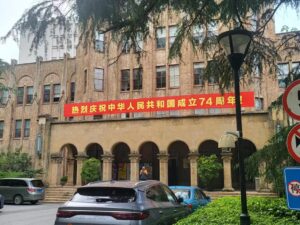
最近の「上海自然科学研究所」
Recent “Shanghai Natural Science Institute”
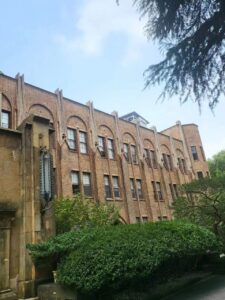
最近の「上海自然科学研究所」
Recent “Shanghai Natural Science Institute”
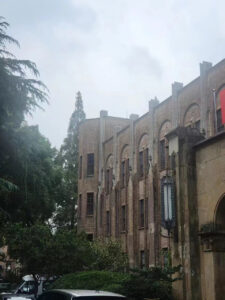
最近の「上海自然科学研究所」
Recent “Shanghai Natural Science Institute”
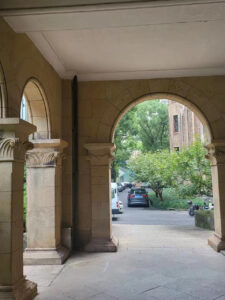
最近の「上海自然科学研究所」
Recent “Shanghai Natural Science Institute”
It is certainly “Uchida Gothic”.
We can feel Uchida Yoshikazu’s taste in every detail.
Despite the fact that the enemy country at the time, Japan, used reparations money from its own country (Qing Dynasty) and designed it by a Japanese architect, the former Shanghai Institute of Natural Science, designed by Uchida Yoshikazu, was designated as an “Excellent Heritage Building” by the Shanghai government, and has been carefully preserved and used by the Chinese side to this day.
When I think about this history between the two countries, I cannot help but hope that Japan-China relations will improve dramatically in the near future.
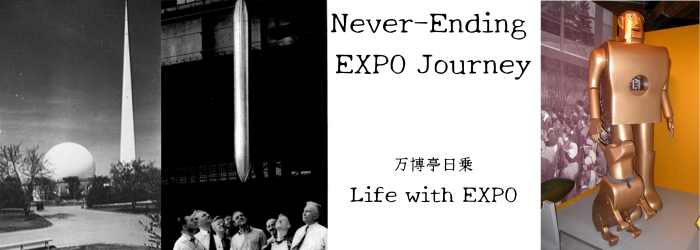
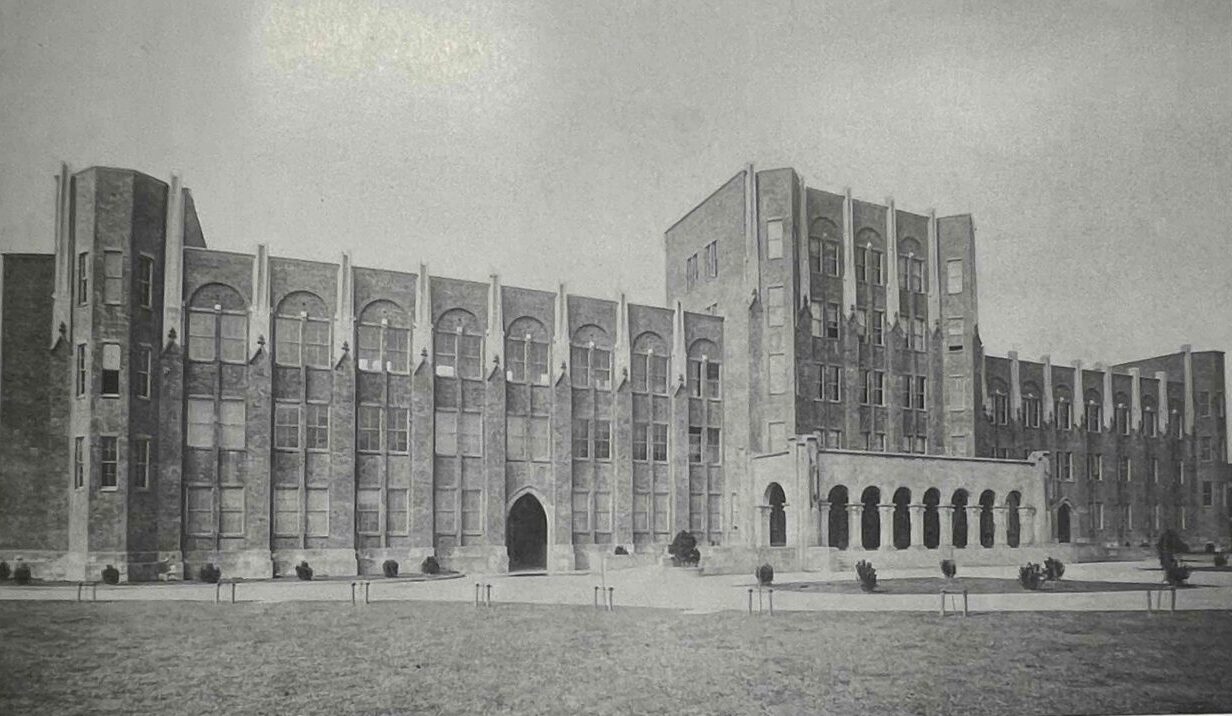
-120x68.jpg)
